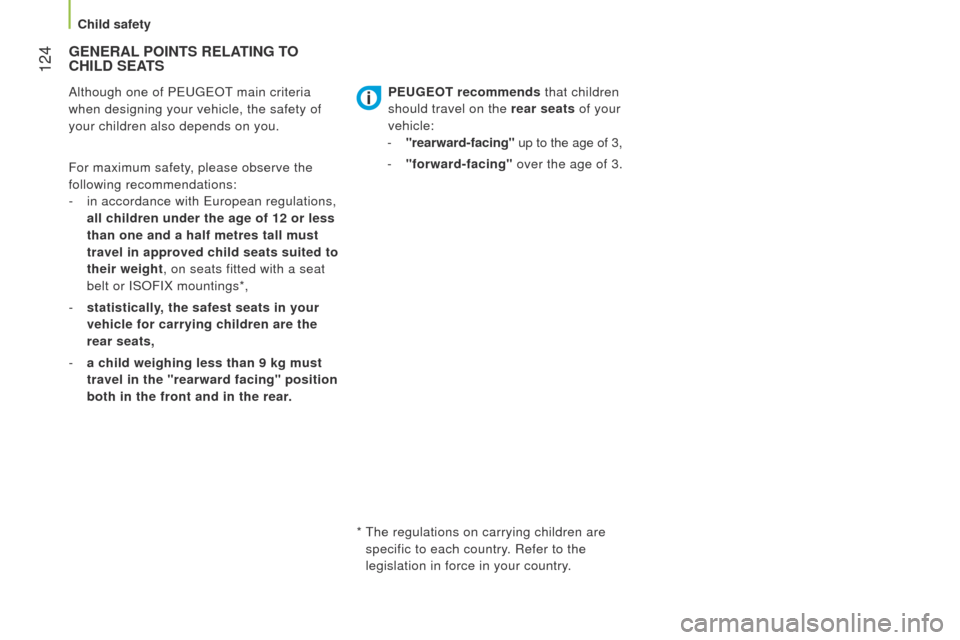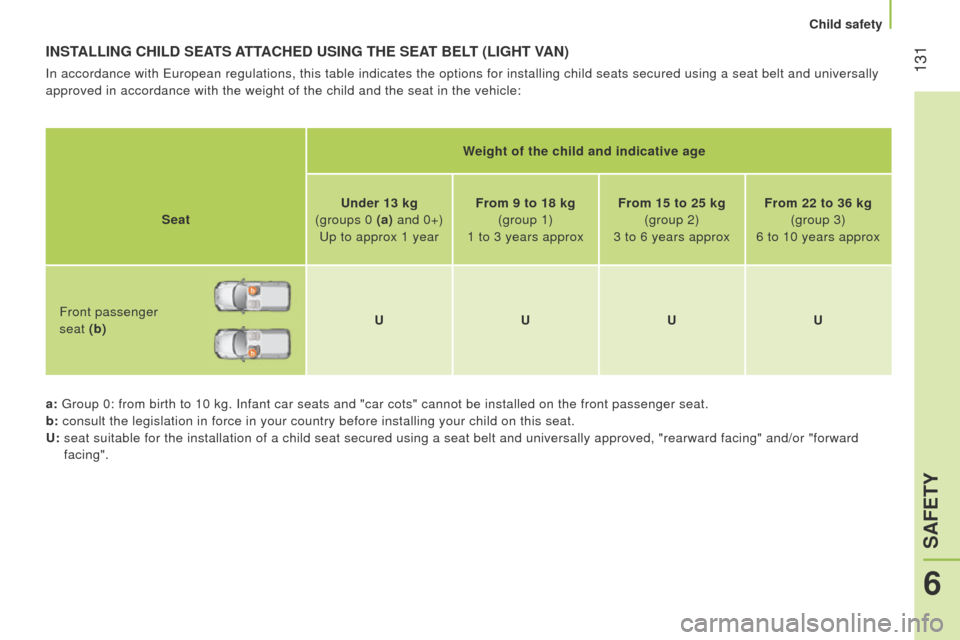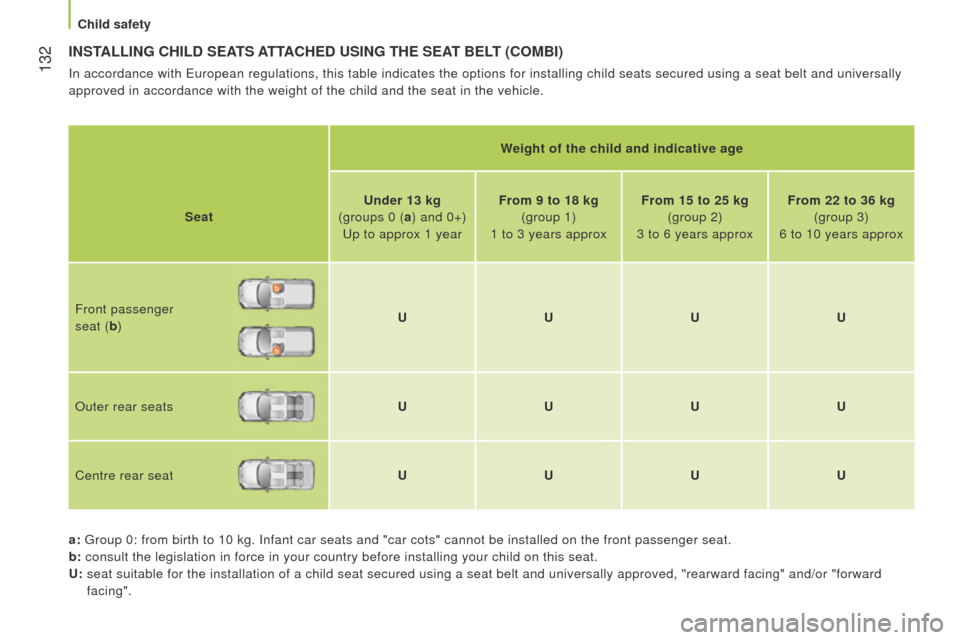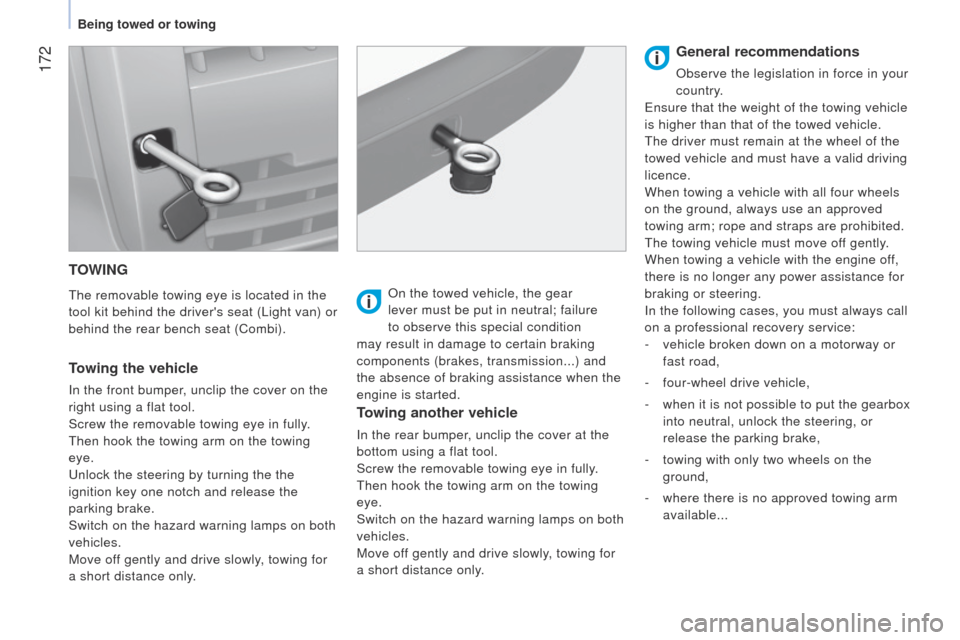2015 Peugeot Bipper weight
[x] Cancel search: weightPage 18 of 192

16
Bipper_en_Chap01_vue-ensemble_ed02-2014
emission controls ....................34, 151
Bulbs, lighting, changing
bulbs
.......
.............................
161-165
Opening the bonnet
....................... 144
u
nder the bonnet
....................
145-146
Identification markings, serial number, paint, tyres
.......
........................... 183 Changing a wiper blade
.................
166
e
ngine technical data
.............180-181
Dimensions
............................ 174-175,
176-177. 178-179
Weights
.......................................... 182
TECHNICAL DATA - MAINTENANCE
levels .....................................147-14 8
●
dipstick,
●
power steering fluid,
●
brake fluid,
●
coolant,
●
screenw
ash.
Checks.................................... 149-151
●
battery
,
●
air/passenger compartment filter
,
●
oil filter
,
●
particle emissions filter (1.3 HDi 75),
●
parking brake,
●
brake pads.
e
ngine fuses
...................167, 170-171
Location
Page 126 of 192

124
Bipper_en_Chap06_securite_ed02-2014
GENERAL POINTS RELATING TO CHILD
SEATS
Although one of PeugeOt main criteria
when designing your vehicle, the safety of
your children also depends on you.
*
t he regulations on carrying children are
specific to each country. Refer to the
legislation in force in your country.
For maximum safety, please observe the
following recommendations:
-
in accordance with
e uropean regulations,
all children under the age of 12 or less
than one and a half metres tall must
travel in approved child seats suited to
their weight, on seats fitted with a seat
belt or ISOFIX mountings*,
-
statistically
, the safest seats in your
vehicle for carrying children are the
rear seats,
-
a child weighing less than 9 kg must
travel in the "rearward facing" position
both in the front and in the rear. PEUGEOT recommends that children
should travel on the rear seats of your
vehicle:
-
"rearward-facing"
up to the age of 3,
-
"forward-facing"
over the age of 3.
Child safety
Page 133 of 192

131
Bipper_en_Chap06_securite_ed02-2014
INSTALLING CHILD SEATS ATTACHED USING THE SEAT BELT (LIGHT VAN)
In accordance with european regulations, this table indicates the options for installing chi\
ld seats secured using a seat belt and universally
approved in accordance with the weight of the child and the seat in the \
vehicle:
W
eight of the child and indicative age
Seat Under 13 kg
(groups 0 (a) and 0+)
u
p to approx 1 yearFrom 9 to 18 kg
(group 1)
1 to 3 years approx From 15 to 25 kg
(group 2)
3 to 6 years approx From 22 to 36 kg
(group 3)
6 to 10 years approx
Front passenger
seat (b) U
UUU
a :
g roup 0: from birth to 10 kg. Infant car seats and "car cots" cannot be i\
nstalled on the front passenger seat.
b : consult the legislation in force in your country before installing your\
child on this seat.
U:
seat suitable for the installation of a child seat secured using a seat \
belt and universally approved, "rearward facing" and/or
"forward
facing".
6
SAFETY
Child safety
Page 134 of 192

132
Bipper_en_Chap06_securite_ed02-2014
INSTALLING CHILD SEATS ATTACHED USING THE SEAT BELT (COMBI)
In accordance with european regulations, this table indicates the options for installing chi\
ld seats secured using a seat belt and universally
approved in accordance with the weight of the child and the seat in the \
vehicle.
W
eight of the child and indicative age
Seat Under 13 kg
(groups 0 (a ) and 0+)
u
p to approx 1 yearFrom 9 to 18 kg
(group 1)
1 to 3 years approx From 15 to 25 kg
(group 2)
3 to 6 years approx From 22 to 36 kg
(group 3)
6 to 10 years approx
Front passenger
seat (b ) U
UUU
Outer rear seats UUUU
Centre rear seat UUUU
a:
g roup 0: from birth to 10 kg. Infant car seats and "car cots" cannot be i\
nstalled on the front passenger seat.
b: consult the legislation in force in your country before installing your\
child on this seat.
U:
seat suitable for the installation of a child seat secured using a seat \
belt and universally approved, "rearward facing" and/or
"forward
facing".
Child safety
Page 138 of 192

136
Bipper_en_Chap06_securite_ed02-2014
LOCATIONS FOR THE INSTALLATION OF ISOFIX CHILD SEATS (COMBI)
In accordance with european regulations, this table indicates the options for the installati\
on of ISOFIX child seats on the vehicle seats fitted
with ISOFIX mountings.
In the case of the universal and semi-universal ISOFIX child seats, the \
child seat's ISOFIX size category
, determined by a letter from A to G,
is indicated on the child seat next to the ISOFIX logo.
IUF: seat suitable for the installation of an I sofix Universal seat, "F orward facing" and secured using the "
t
op tether" upper strap.
IL-SU:
seat suitable for the installation an I sofix Semi-U niversal seat which is:
-
"rearward facing" fitted with a "
t
op tether" upper strap or a support leg,
-
"forward facing" fitted with a support leg,
For securing the "
t
op tether" upper strap, refer to the "Isofix Mountings" section.
X:
seat which is not suitable for the installation of an ISOFIX seat of th\
e size category indicated. Weight of the child / indicative age
Less than 10 kg (group 0)
u
p to 6 months approx Less than 10 kg
(group 0)
Less than 13 kg
(group 0+)
u
p to 1 year approxFrom 9 to 18 kg (group 1)
From 1 to 3 years approx
Type of ISOFIX child seat Infant car
seat* "
rearward facing" "
rearward
facing" "forward facing"
ISOFIX size category F G C D E C D A B B1
Universal and semi-universal ISOFIX child
seats which can be installed on the outer
rear seats X
IL-SU IL-SU IUF
* Infant car seats and "car cots" cannot be installed on the front passe\
nger seat.
Child safety
Page 140 of 192

138
Bipper_en_Chap07_accessoire_ed02-2014
In certain cases of particularly arduous
use (towing the maximum load up a steep
slope in high temperatures), the engine
automatically limits its power. In this case,
automatic cutting off of the air conditioning
allows the engine power to be saved.If the coolant temperature
warning lamp comes on, stop the
vehicle and switch off the engine
as soon as possible.
ChecksSee the "
l evels" section of
chapter 7.
Tyres: check the tyre pressures on the
towing vehicle and the trailer, observing the
recommended pressures.
Brakes: towing increases the braking
distance. Drive at a moderate speed,
change down early and brake gradually. Side wind: sensitivity to side wind is
increased. Drive smoothly and at a
moderate speed.
ABS: the system only controls the vehicle,
not the trailer.
Distribution of loads
Distribute the load in the trailer so that the
heaviest objects are as close as possible
to the axle and the nose weight is close to
the maximum authorised without, however,
exceeding it.
t
he air density decreases with
altitude, so reducing the performance of the
engine.
t
he maximum towed load must be
reduced by 10 % for each 1 000 metres of
altitude.
Refer to the "
t
echnical data -
Identification markings" section. Rear parking sensors: the sensors will be
deactivated automatically when an genuine
P
euge O t towbar is used.
Towbar
We recommend the use of genuine
P
euge O t towbars and their harnesses,
which have been tested and approved from
the design stage of your vehicle, and that
the fitting of this equipment is entrusted to a
P
euge O t
dealer or a qualified workshop.
If this equipment is not fitted by a P
euge O t
dealer
, it is essential that it is fitted using
the electrical pre-equipment located at
the rear of the vehicle and following the
manufacturer's instructions.
t
he operation of the rear parking sensors is
deactivated automatically when the trailer
cable connector is inserted in the towbar
socket.
When the trailer cable is removed, the rear
parking sensors are re-activated.
Refer to the "
t
echnology on board -
Parking sensors" section.
For information on the maximum
weights and towed loads applicable to
your vehicle, refer to the "
t
echnical data -
Weights" section.
Towing a trailer
Page 141 of 192

139
Bipper_en_Chap07_accessoire_ed02-2014
ROOF RACK AND ROOF BARS
to install the transverse roof bars or a
roof rack, use the fixings provided for this
purpose.
Maximum load: 75 kg.
OTHER ACCESSORIES
A wide range of accessories and genuine
parts is offered by the P euge O t
network.
t
hese accessories and parts have been
tested and approved both for reliability and
for safety.
t
hey all benefit from P euge O t 's
recommendation and warranty.
Never exceed the gross vehicle
weight (
g
VW).
Range of professional equipment
the replacement parts department publishes
an accessory catalogue of fering various
equipment and fittings, such as:
-
wooden protective floor
, non-slip wooden
floors, wooden side protectors, glass
protection grilles,
-
roof rack, set of transverse roof bars,
loading roller,
-
towbars, towbar harnesses with
7/13
sockets, 7/7 sockets, 13 socket...
t
he fitting of electrical equipment or
accessories not listed by P euge O t
may result in the failure of your vehicle's
electronic system or high consumption.
Please note this specific warning. You
are advised to contact a representative
of P euge O t
to be shown the range of
recommended equipment and accessories.
Depending on the country in which the
vehicle is sold or operated, it may be
compulsory to have a high visibility vest,
warning triangle, replacement bulbs and
fuses available in the vehicle.
Before installing accessory radio
communication transmitters with
external aerial on your vehicle, you can
contact a P
euge O t
dealer
, who will provide
the specification (frequency band, maximum
output power, aerial position, specific
installation conditions) of the transmitters
which can be fitted, in accordance with the
Motor Vehicle
e lectromagnetic Compatibility
Directive (2004/104/
e C).
When fitting a towbar and harness
outside the P
euge O t
dealer
network, the installation must be done
using the electrical pre-equipment on the
vehicle and following the manufacture's
recommendations.
7
ACCESSORIES
Equipment
Page 174 of 192

172
Bipper_en_Chap09_aide-rapide_ed02-2014
TOWING
the removable towing eye is located in the
tool kit behind the driver's seat ( l ight van) or
behind the rear bench seat (Combi).
Towing the vehicle
In the front bumper, unclip the cover on the
right using a flat tool.
Screw the removable towing eye in fully.
t
hen hook the towing arm on the towing
eye.
u
nlock the steering by turning the the
ignition key one notch and release the
parking brake.
Switch on the hazard warning lamps on both
vehicles.
Move off gently and drive slowly, towing for
a short distance only. On the towed vehicle, the gear
lever must be put in neutral; failure
to observe this special condition
may result in damage to certain braking
components (brakes, transmission...) and
the absence of braking assistance when the
engine is started.
Towing another vehicle
In the rear bumper, unclip the cover at the
bottom using a flat tool.
Screw the removable towing eye in fully.
t
hen hook the towing arm on the towing
eye.
Switch on the hazard warning lamps on both
vehicles.
Move off gently and drive slowly, towing for
a short distance only.
General recommendations
Observe the legislation in force in your
country.
e
nsure that the weight of the towing vehicle
is higher than that of the towed vehicle.
t
he driver must remain at the wheel of the
towed vehicle and must have a valid driving
licence.
When towing a vehicle with all four wheels
on the ground, always use an approved
towing arm; rope and straps are prohibited.
t
he towing vehicle must move off gently.
When towing a vehicle with the engine off,
there is no longer any power assistance for
braking or steering.
In the following cases, you must always call
on a professional recovery service:
-
vehicle broken down on a motorway or
fast road,
-
four-wheel drive vehicle,
-
when it is not possible to put the gearbox
into neutral, unlock the steering, or
release the parking brake,
-
towing with only two wheels on the
ground,
-
where there is no approved towing arm
available...
Being towed or towing